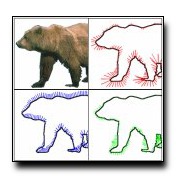
Figureground organization refers to the visual perception that a contour
separating two regions belongs to one of the regions. Recent studies have found
neural correlates of figureground assignment in V2 as early as 1025 ms after
response onset, providing strong support for the role of local bottomup
processing. How much information about figure ground assignment is available
from locally computed cues? Using a large collection of natural images, in
which neighboring regions were assigned a figureground relation by human
observers, we quantified the extent to which figural regions locally tend to be
smaller, more convex, and lie below ground regions. Our results suggest that
these Gestalt cues are ecologically valid, and we quantify their relative
power. We have also developed a simple bottomup computational model of
figureground assignment that takes image contours as input. Using parameters
fit to natural image statistics, the model is capable of matching human-level
performance when scene context limited.
Download: pdf
Text Reference
Charless C. Fowlkes, David R. Martin, and Jitendra Malik.
Local figure-ground cues are valid for natural images.
Journal of Vision, 7(8):1–9, 2007.
URL:
http://journalofvision.org/7/8/2/.
BibTeX Reference
@article{FowlkesMM_JOV_2007,
author = "Fowlkes, Charless C. and Martin, David R. and Malik, Jitendra",
title = "Local figure-ground cues are valid for natural images",
journal = "Journal of Vision",
volume = "7",
number = "8",
url = "http://journalofvision.org/7/8/2/",
year = "2007",
pages = "1--9",
tag = "ecological_statistics"
}
